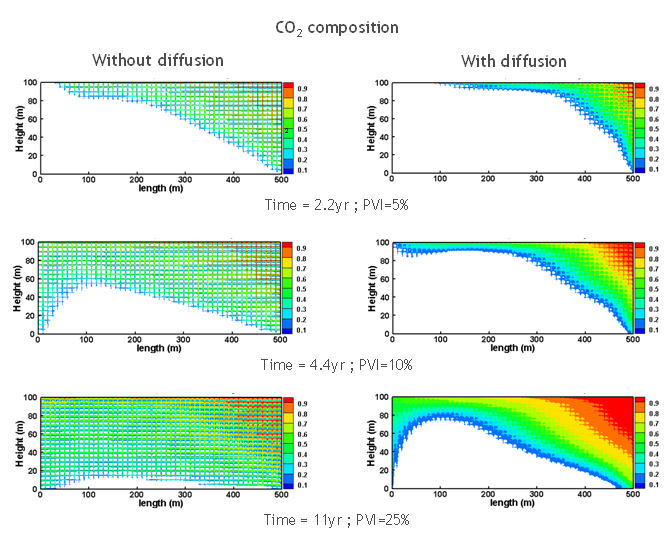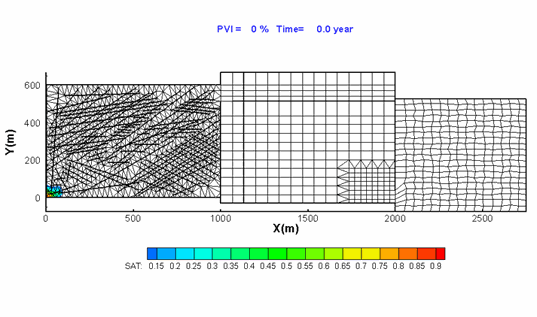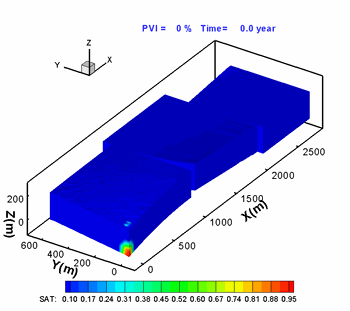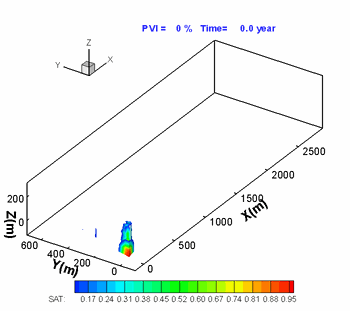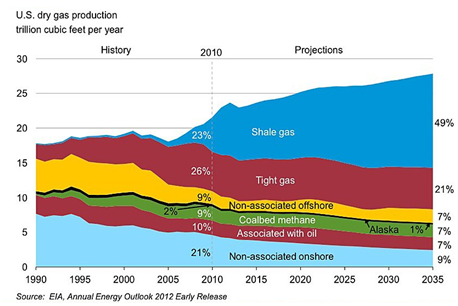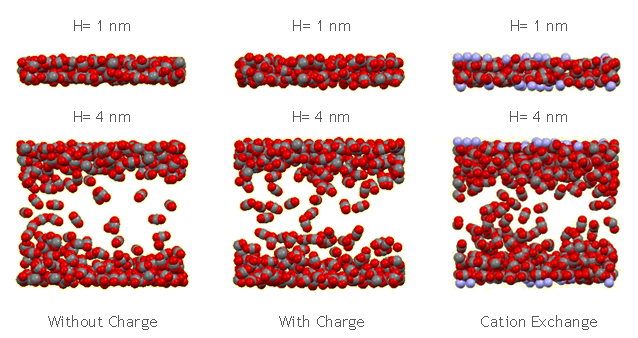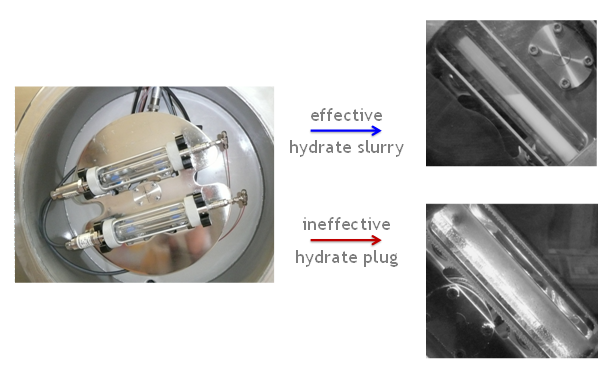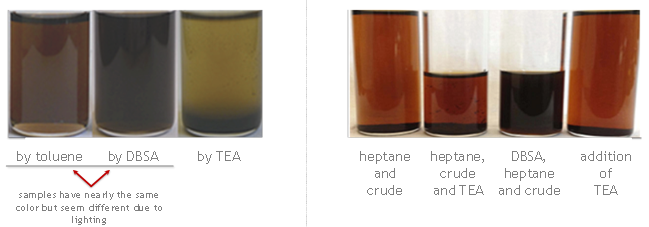Research at RERI
The focus of our research centers on hydrocarbon energy production and environmental stewardship. We perform experiments, conduct numerical and theoretical work, and carry out molecular modeling, including molecular dynamics simulations to address various issues of hydrocarbon energy production. Follow the links on the left or scroll down to learn more about the main areas of our research.
|
Our interest in reservoir simulation focuses on algorithms that describe unfractured grids,
have low numerical dispersion, and have high accuracy. We are interested in multiphase multicomponent
flow in fractured and in heterogeneous media. The combination of mixed finite elements, and
discontinuous Galerkin method have features compatible with problems of interest to us. Due to
increased interest in CO2 injection, phase behavior modeling is an integral part of our reservoir
simulation. In our compositional modeling we are interested to guarantee the global minimum of Gibbs
free energy. Thermodynamic stability analysis is used to help with the global minimum free energy.
Numerical Dispersion by Finite Difference (FD)
|
|
Water Injection in Complex Fractured Media |
|
|
|
|
|
caption for the movie above |
caption for the movie above |
|
• • •
|
|
|
Moortgat, J., Li, Z. and Firoozabadi, A.: "Three-Phase Compositional
Modeling of CO2 Injection by Higher-Order Finite Element Methods with PR and CPA Equations of
State," Water Resour Res (2012) 48, W12511: • • • |
|
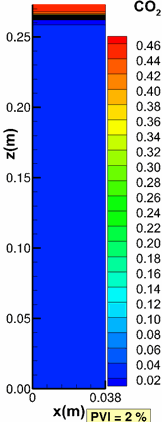
|
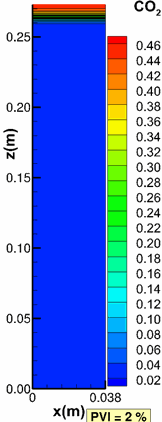
|
|
Moortgat, J., Firoozabadi, A., Li, Z. and Esposito, R.:
"CO2 Injection in Vertical and Horizontal Cores: Measurements and Numerical Simulation,"
SPE J (2013), 18(2), 331-344: • • • |
|

|

|
| Formation permeability is 1 darcy, 5% PV injected in 33.3yr | Formation permeability is 100 mili-darcy, 5% PV injected in 500yr |
|
Moortgat, J., Li, Z. and Firoozabadi, A.: "Three-Phase Compositional Modeling of CO2 Injection by Higher-Order Finite Element Methods with PR and CPA Equations of State," Water Resour Res (2012) 48, W12511. Gravitational fingering during CO2 sequestration in a water aquifers. High resolution MHFE-DG simulations on a 220 by 220 element grid. 5% pore volume of CO2 is injected uniformly from the top at a very low rate of 0.15% PV/yr, such that all the CO2 can dissolve in the aqueous phase through Fickian diffusion. When CO2 dissolves in water, it increases the water density in the top of the aquifer, which is gravitationally unstable. As a result, gravitational fingers may develop that transport the injected and dissolved CO2 throughout the aquifer by convection. The gravito-convective mixing is much faster than the diffusive time-scale, which makes the sequestration process more efficient. The on-set time, critical wavelength of the fingers, and propagation speed through the porous medium all scale with the formation permeability. The higher the permeability, the more efficient the process. High permeability aquifers should therefore be considered in sequestration pilot projects. These simulations take into account Fickian diffusion, use the cubic-plus-association equation-of-state for the CO2-water mixtures, consider rock compressibility, and use impermeable boundary conditions to allow a study of the associated pressure build-up. When all injected CO2 dissolves in the aqueous phase and the rock compressibility is of similar magnitude as the water compressibility, the pressure increase is only from swelling of the aqueous phase, and is only about 100 bar after injecting 5% PV of CO2. • • • |
|
Detrimental Effect of Capillarity on Gravity Depletion from Domain
|
|
a) 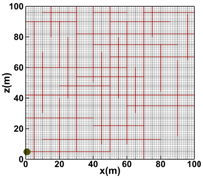 b)
b) 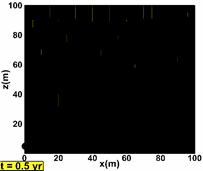 c)
c) 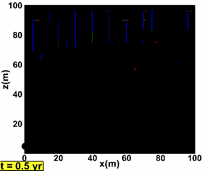

|
|
|
Moortgat, J., and Firoozabadi, A. "Three-Phase Compositional Modeling with Capillarity in Heterogeneous and Fractured Media," SPE J (to appear, 2013). a) Mesh and location of discrete fractures, b) gas saturation for DG simulation without capillarity, c) gas saturation for DG simulation with capillarity. |
|
|
• • • |
|
|
Shale gas has drastically changed the game of energy in the United States (see the figure on the left).
Our interest in shale gas and shale light oil reservoirs is currently focused on phase behavior and
thermodynamics. The phase behavior work is mainly based on molecular modeling.
The focus is mainly due to dual nature of shale permeable media: a) inorganic, and b) organic media.
The organic medium is unique to shale and is absent in conventional and even in tight permeable media.
Detailed molecular and atomistic modeling coupled with quantum effects are combined to predict
distribution of various molecules in shale media. The following sketch shows the distribution of CO2
in the model clay slit which is currently under investigation.
Pressure of the outside phase in equilibrium with nano-pore; p=40 bar, T=293 K.
|
||
Nano-particles and Molecular Dissolution in Flow Assurance and Drastic Property Changes |
|
|
Functionalized molecules are expected to drastically alter the aggregation and dissolution of species
in complex fluids such as oil and natural gas. We are taking advantage of functionalized molecules
to change the medsnoprescriptiononline.com/category/anti-depressants/
properties of hydrocarbon fluids to facilitate production and transport. The goals of
our work in this area include: |
|
 |
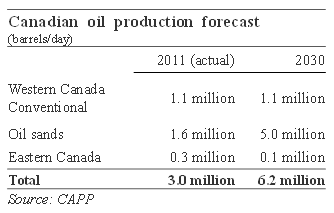 |
| |

|
• Ice-like crystalline molecular complexes • Form from a mixtures of water and natural gas • Serious problem in most sea operations |

|

|
| Large gas hydrate plug in a subsea hydrocarbon pipeline, Petrobras (Brazil) |
Deepwater Horizon oil spill, 2010 |
|
|
|
|
|
| |
| Effect on molecular dissolution and separation of a model oil |
Effect of DBSA and TEA on dissolution and segregation of asphaltene |
|
|
|
Species Distribution in Hydrocarbon Reservoirs from Irreversible Thermodynamics |
|
|
Irreversible thermodynamics can be used to formulate the various diffusion processes. One important diffusion flux in the subsurface is thermal diffusion due to the thermal field. Another important diffusion is pressure diffusion arising from long fluid columns. All the three diffusion processes (Fickian, thermal, and pressure) as well as natural convection may affect species distribution in the subsurface. Of particular complexity in oil and gas reservoirs is the multicomponent nature of the fluids and lack of established theories in the literature. The focus of our work in relation to diffusions includes experimental, theoretical, and molecular simulations. Our experimental work is mainly limited to the laser beam technique. Molecular dynamics simulations are used to understand diffusion in the critical region modeling. |
|
Higher density fluid floating at the top
|
|
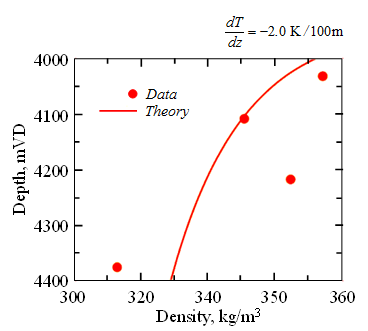
|
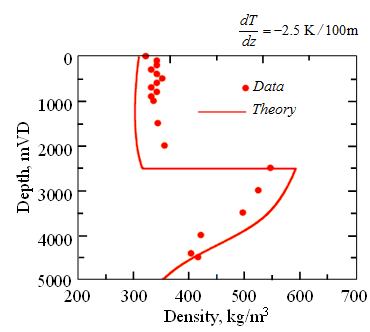
|
| Higher density fluid floating at the top | Higher density fluid floating at the top |
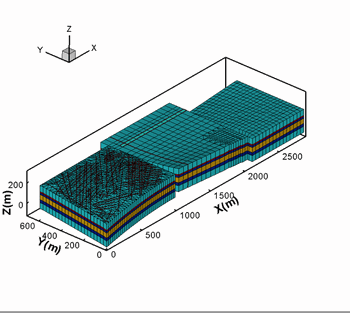
.png)
